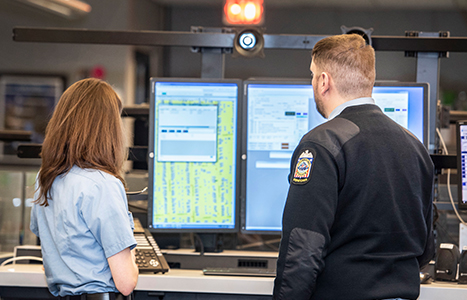Emergency Communications Center (E.C.C.)
911 Emergency Communications Center Training

All employees hired by the City of Columbus go through the same training no matter of experience. All training starts with 911 Emergency Call Taker training. It takes approximately six months to be trained and released on your own as a 911 Emergency Call Taker in the City of Columbus.
Call Taker Classroom Training (10 weeks)
Classroom instruction involves presentations, lectures, hands-on practical learning, and application under the guidance of the Communications Bureau Training Academy. Included will be information on:
• Expectations of the Training Program
• Division of Police Policy & Procedure
• Police Ten Codes
• Geography
• Public Safety Language
• Hexagon Computer Aided Dispatch System (CAD)
• West Phone System
• Resources
• Support Services
• Forms / Intranet
• Citywide Orientation (Sexual Harassment, Substance Abuse, etc.)
Required Certifications: (Certifications
will be acquired during training.)
• CPR
• Incident Command System (ICS) – IS 100.I.E.b
• ICS for Single Resources and Initial Action Incidents – IS 200.b
• National Incident Management System (NIMS) – IS 700.a
• National Response Framework, An Introduction – IS 800.b
• Law Enforcement Automated Data System (LEADS) / National Crime Information Center (NCIC)
• Emergency Medical Dispatch and Emergency Fire Dispatch
There are also daily quizzes, exercises, practical exercise, and a comprehensive final exam (question & answer and practical). Employees must maintain a 70% average throughout the classroom training and pass the final exam with a score of 70 on both the written and practical portions of the exam.
Call Taker On The Job Training (12 weeks)
The next step in the training process is three months of on-the-job training. During this training trainees are exposed to different shifts and coaches for four weeks at a time. Trainees will be accessed with Daily Observation Reports that let the trainee know how they are progressing. At the end of the twelve week period the trainees that demonstrate satisfactory ability to do the job will be released onto the floor to begin working independently.
Once a 911 Emergency Call Taker has worked in their position for two years they become eligible to test for a promotion to 911 Emergency Dispatcher. If you are hired as a 911 Emergency Dispatcher you will automatically advance to your dispatch training after completing the call taker training.
Dispatch Classroom Training (4 weeks)
Classroom instruction involves presentations, lectures, hands-on practical learning, and application under the guidance of the Communications Bureau Training Academy. Included will be information on:
• Support Agencies
• CAD functions and Procedures
• Overall Dispatching Techniques
• Motorola Radio System
• Policies and Procedures specific to dispatch
Daily Quizzes, Exercises, Practical Exercise (with trainers), Comprehensive Final Exam (written and practical).
After final exam:
• Police Ride Along
Dispatcher On The Job Training (16 weeks)
The next step in the dispatcher training process is four months of on-the-job training. During this training trainees are exposed to different shifts and coaches for four weeks at a time. Trainees will be accessed with Daily Observation Reports that let the trainee know how they are progressing. During this time the trainee will also work as an independent call taker for half of their shift. At the end of the sixteen week period the trainees that demonstrate satisfactory ability to do the job will be released onto the floor to begin working independently.